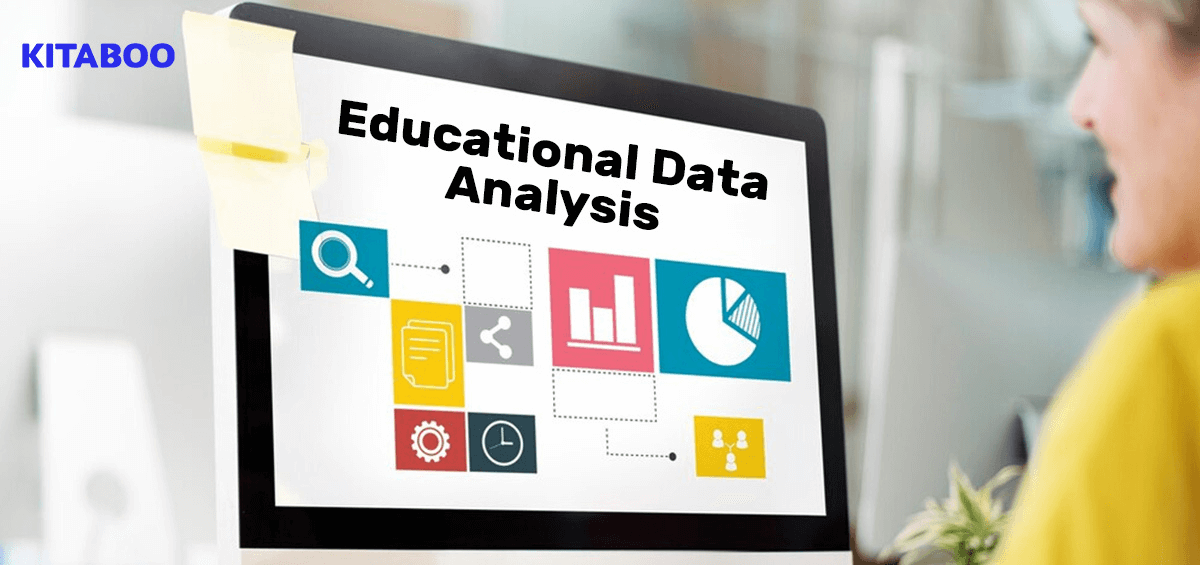Today, a growing amount of educational content is available online and offline. Content is available in several formats, such as videos, blogs, quizzes, physical textbooks, and eBooks, to name a few. Learners can access this content via apps, platforms, and websites.
Education providers invest significant effort to create and disseminate content to learners. However, two challenges impact education providers.
- They cannot gauge learning effectiveness despite producing such high-quality content.
- They are unable to leverage data to further improve teaching pedagogy effectively.
This is where superior education data analysis comes into use, helping education providers leverage data to enhance teaching strategy. For instance, KITABOO‘s cutting-edge digital textbook platform comes equipped with strong data analysis capabilities. Let’s understand more about this secret weapon in the education provider’s arsenal and its benefits.
Table of Contents
I. What is educational data analysis?
II. How educational data analysis shapes teaching strategy
III. 4 Benefits of Educational Data Analysis
- Tracking Learner Progress
- Gauging Individual Learner Needs
- Detecting Key Problem Areas
- Predicting Learning Trends
IV. How to access educational data analysis
V. Conclusion
What is Educational Data Analysis?
Education data analysis is the automated measuring, collating, analyzing, and reporting of data connected to learner progress, learning effectiveness, and usage of learning resources.
Education providers, teachers, and other stakeholders can leverage the data to better understand whether learning content is effective. They can strategize on how to make learning environments optimized. Key learning problem areas can be detected, and teaching strategies can be developed to meet challenges.
Educational institutes and content providers can develop a data-driven approach to decision-making and design content and learning environments based on scientific fact rather than ad hoc.
How Educational Data Analysis Shapes Teaching Strategy
Traditionally, education delivery has been a linear process through classroom lecture-based methods. Educational institutes could assess students’ progress based on exams hosted once a year or at shorter intervals. There has been a limited opportunity to gauge the impact of offline engagement on a student’s progress.
However, digital innovation has disrupted this limitation. Digital textbook creation platforms such as KITABOO can capture the online footprint of learners in-depth and automatically turn raw data from multiple sources into meaningful insights. For instance, an education content creator can track the usage patterns of an eBook on the platform by the page, multimedia content such as videos, and functionalities such as search to understand how users engage with the content. They can shape future eBooks based on usage patterns.
Such in-depth educational data analysis is a powerful tool to overhaul redundant teaching methodologies and upgrade them to be relevant to today’s learners.
4 Benefits of Educational Data Analysis
Here is a look at how high-quality education data analysis enables education textbook creators to enhance teaching strategies.
Tracking Learner Progress
Education data analysis helps keep track of how learners respond to educational resources. It is possible to ascertain:
- How much time learners are spending on learning resources?
- Which are the popular resources?
- Which file formats work well?
- What time do learners log in?
- How many times a day do they log in?
- What are the least popular resources?
Data from interactive content pieces, such as tests, quizzes, and exams, provide insights into learner progress. Data can be spliced and diced in multiple ways, offering education providers insights on how to shape curriculum and pedagogy.
Gauging Individual Learner Needs
Another stellar benefit of education data analysis is that education providers can gauge the progress of individual students rather than a class as a cohort. This is a valuable benefit as every student has unique needs. Students may have unique needs in the spectrum of a disability, learning limitations, and mobility challenges.
They may have unique strengths and a flair for one subject while faring poorly in another. Education providers can drill down the specifics of each student’s strengths and weaknesses and develop lessons that cater to their needs. They can coach students to build knowledge and skills in areas where they are weak. The general trend in education is also towards adapting lessons to a learner’s proficiency rather than offering a one-size-fits-all curriculum.
Detecting Key Problem Areas
Superior educational data analysis can point education providers toward areas where many students struggle. Common struggles point towards the need for larger innovation in the curriculum and teaching methodology.
For example, if many learners struggle with specific mathematical and physics concepts, education providers can introduce multimedia resources that demonstrate these concepts through gamification. Interactive quizzes can also be introduced to help students test their knowledge at regular intervals.
Predicting Learning Trends
The education system has struggled with updating the curriculum regularly due to a lack of data and an efficient means to do so at scale. However, this is extremely important in a modern context when changes in the world of work are taking place much faster due to the acceleration of digital transformation.
Regular educational data analysis enables education providers to upgrade the curriculum faster based on the patterns emerging from learner behavior. For instance, if education providers find that more learners are choosing to learn via mobile phones, they can optimize all content, such as eTextbooks for mobile.
How to Access Educational Data Analysis
Accessing high-quality data analysis is an ongoing challenge for education Institutions and providers. The platform may not provide superior education data analysis. Leveraging legacy analytics platforms may not provide in-depth and predictive analysis.
This is where cloud-based, Artificial Intelligence (AI) driven automated digital textbook platforms such as KITABOO are revolutionizing how educational content can be created and disseminated and learning effectiveness tracked.
Using AI in educational data analysis offers predictive insights, which can particularly help education content creators disrupt their understanding of learner needs and reframe content in the future. They can customize dashboards, access detailed reports on learner habits, and predict needs.
This is also a cost-effective solution, as education content creators can work with a subscription pricing model rather than pay for purchasing and maintaining on-premise servers and software.
The Takeaway
Access to high-quality learner data analysis is a growing need for education content creators to stay relevant in today’s day and age. This is because the needs of learners keep evolving in real time.
More attention must also be paid to individual learner progress to raise the overall impact of learning effectiveness. Education content creators can stay competitive and benefit from educational data analysis by adopting cloud-based, AI-enabled digital textbook creation platforms.
Education publishers and providers can leverage state-of-the-art cloud-based digital textbook platforms like KITABOO to publish, distribute, market, and amplify their solutions to their audiences worldwide.
Connect with us to start a conversation.
Suggested Reads:
Discover How An Ebook Conversion, Publishing & Distribution Platform Can Help You
Kitaboo is a cloud-based content platform to create-publish & securely distribute interactive mobile-ready ebooks.
You May Also Like









